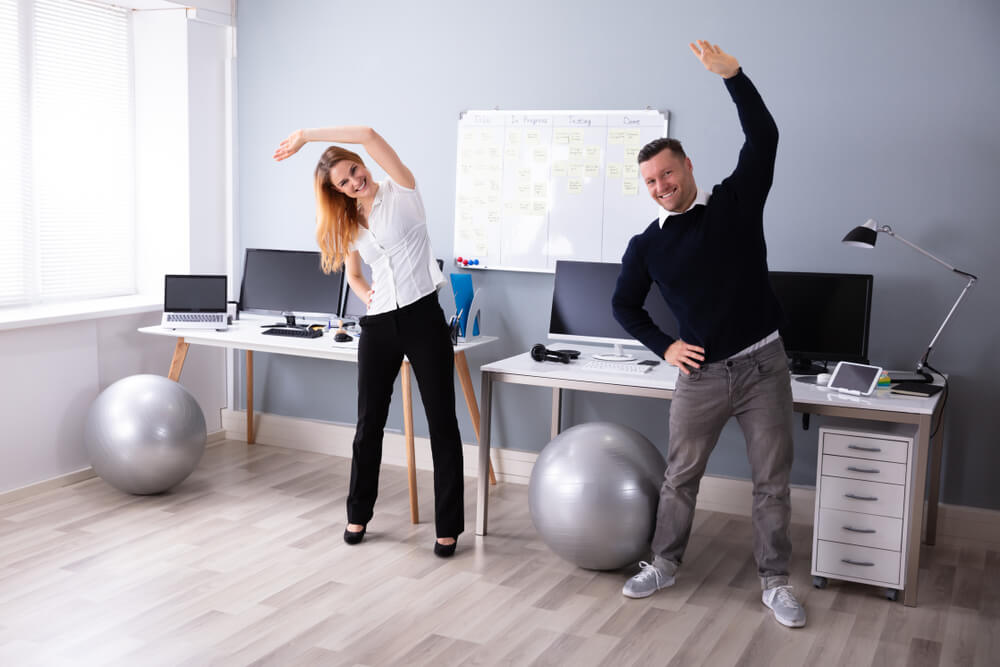Taking care of your employees is an essential part of motivating staff to perform at optimum levels. If workers sit at the same desk all day, they need to stand and stretch periodically to achieve adequate blood flow. Deep breathing also helps relieve the tension built up from inactivity. Here is what you should know about standing desk exercises to help promote a healthier workplace.
Why Do You Need to Move?
The purpose of periodic exercise for standing desk work is to allow the maximum possible mobility in an office environment for several muscles and organs. Keeping muscles active is vital for their long-term development. Sitting at the same place throughout the day can create tension in various parts of the body to the point of turning into excruciating pain and even prolonged illness. Such ailments commonly affect the neck, chest, hips, and stomach.
Deep Breathing Exercises
Here are some of the many exercises you can do at a standing desk which involves deep breathing to relax the nervous system:
● Diaphragm Breathing –
Inhaling and exhaling with the shoulders held back helps air pass through the diaphragm more efficiently, which eases tension in the stomach and chest muscles.
● Seated Heart Opener –
While sitting in a chair with your legs crossed, grab the back of the chair’s bottom with the fingers of your other hand near the base of your spine. Lift your chest while pulling your shoulders down and back and take about five deep breaths through the chest and stomach. Do this process with both legs.
● Seated Thoracic Rotation –
This exercise eases tension in the back and facilitates more comfortable breathing. Lean forward in your chair, gripping your hands in front of your chest. Then exhale slowly while turning your neck and spine to the side and hold the position a few seconds. Do it a few times for both directions.
These breathing exercises are ideal for introducing you to the concept of brief daily workouts. They involve minimal movement and strain while generating a sense of relaxation for your nervous system.
Sitting in the same position all day is taxing enough on your body, especially if you aren’t using good posture. Part of achieving proper breathing is sitting up straight. Once you become comfortable with breathing exercises, you can move on to stretching.
Stretching Exercises
The following are some of the various exercises you can do at a standing desk which involve stretching to move muscles throughout the body:
● Segmented Cat-Cow –
This exercise provides upper and lower back mobility while sitting down. It involves moving your chest upward as you bend your neck back with your eyes looking at the ceiling.
● Figure Four Stretch –
Providing relief for your hips and lower back, this exercise involves sitting tall in a chair as you inhale for a few minutes. This activity helps you straighten out your spine.
● Deep Ab Muscle Stretch –
Known as Standing Door Frame QL, this exercise promotes a straight spine aligned with the vertebrae and pelvis. Roll your shoulders back while sitting up with proper posture, allowing sufficient blood flow to the brain.
Some activities to increase mobility are more extensive than others. Fidgeting is a technique involving the movement of the entire body as you shift weight from side to side. It consists of applying circular motion to your neck, ankles, wrists, and toes. Once you’ve mastered breathing and stretching techniques, you can move on to strength-building exercises. Squatting, for example, builds muscle strength in areas such as the hips and chest.
These standing desk exercises will ensure greater mobility and increased blood flow to the brain, thereby enhancing overall productivity.
Contact the experts at Proforma Construction, Bay Area, for all your construction needs. We are available at your service even during the pandemic.




